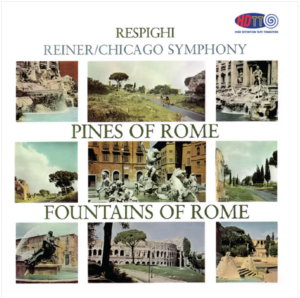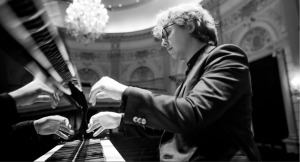Turn up the volume and prepare for sumptuous sonics from one of the great performances in the catalog. This new transfer from High Definition Tape Transfers is terrific. It is now my personal standard for what this great RCA Living Stereo recording can sound like.
Respighi Pines of Rome & Fountains of Rome, Fritz Reiner, Chicago Symphony Orchestra. HDTT 1959 2024 (DSD256 DXD) HERE
Certainly you know this music and this recording. If not, you need to become acquainted. This is one of the great recordings in the RCA Living Stereo catalog and has long been the performance by which all others have been measured.
This new transfer by High Definition Tape Transfers from a 2-track 15-ips analog tape is spacious, clean, transparent, utterly natural sounding, and immensely detailed. The dynamic range is stupendous in the way that really great 15ips tapes can sound. No compression is applied, so expect the soft passages to be really low volume and the crescendos to knock you out of your seat. For example, the final movement of Pines of Rome, "The Pines Of The Appian Way," starts out so softly I wanted to turn up my volume control. But by the conclusion, the huge volume that began to blast out (showing just how loud a full symphony orchestra can sound) had me diving to turn the volume down a bit. For realism in the listening room, this approaches as good as it gets.
Lewis Layton, the redoubtable RCA recording engineer for almost all of the Reiner recordings in Orchestra Hall, has the sound field dialed in just right on this 1959 recording. Wide, spacious, immensely detailed, with no apparent spotlighting. The closing bells in "The Villa Medici Fountain At Sunset" (final movement of Fountains of Rome) are in the far rear corner of the stage, located very precisely. And their sound simply rolls out and over the orchestra in rich tones. Delightful.
Bob Witrak does not specify his source for this tape, so we can only guess. And I'll not speculate here. But, from wherever this tape may have come, it is totally excellent. As is his usual practice with these vintage tapes of classical music, it was first transferred directly to DSD256 and then post-processed in a Pyramix DXD session. Bob releases both the DXD file (24-bit 352.8kHz PCM) and a DSD256 render from that DXD file. I'm listening to the DXD file, but have compared it to the DSD256 file which I also downloaded. As always, your mileage may vary depending on your DAC. So, I encourage you to buy the DSD256 which will then allow you to download all other file formats for comparison. (And, as I do, to have the 96kHz file for listening in the car.)
For comparison, I listened to the Analog Productions SACD release (as a DSD64 file) and the CD and DSD64 layers of the RCA Hybrid SACD release (both as files).
The AP SACD is competitive, but it sounds punched up and not nearly as natural in instrumental timbre. If I were to guess, it sounds like the upper midrange has been boosted for more presence. So, it literally jumps out at me in a rather unpleasant way by comparison to this more neutrally balanced HDTT transfer. The bells with which "The Villa Medici Fountain At Sunset" closes (see above) are decidedly less rich, rounded and resonant.
The RCA SACD DSD64 layer is more neutrally balanced than the AP, to my ears. But, it lacks the ultimate resolution and tonal richness of the HDTT transfer. The CD layer is, well, a CD, with all that entails.
Unfortunately, I no longer have my copy of the 45rpm Classic Records vinyl reissue, but my aural memory casts back to those wonderful slabs of vinyl for a closer comparison to what I hear on this HDTT transfer. (Did you hear bad things about the Classic Records releases of the Living Stereo albums? Well, those negative comments were about the early 33rpm issues. When the 45rpm releases were cut, the technology chain had been completely revamped and the sound quality was from a different universe.)
In sum, if you listen to digital, this HDTT reissue is highly recommended. The sound quality far exceeds the two earlier digital releases I have here to compare.










































